To make sure your software attracts your target audience, it’s essential not only to offer beautiful designs and helpful features but to build the right type of application.
Cloud-based applications become more popular among businesses every year. In 2023, 78% of executives surveyed by PwC said that their companies had adopted cloud technologies in most parts of their business. Cloud-based software is easy to use, doesn’t need to be installed locally, and can be accessed from almost any device in any location.
However, to deliver a competitive and efficient cloud-based app, you need to know what nuances to expect, what skills to look for in your development team, and what workflow to implement.
Read on for an in-depth look at the benefits your business can gain from cloud application development and discover a step-by-step guide to building a cloud project. This article will be helpful for product specialists and project leaders planning to launch a cloud application and looking for insights.
Cloud apps: concept and types
What is a cloud-based app?
A cloud-based application is deployed in a cloud environment. Its architecture can vary, but the core components include:
- Front end 一 the part the user sees and interacts with to perform tasks in the cloud.
- Back end 一 the part that processes data and makes the app function. It usually comprises:
- Storage 一 a virtual place to manage and securely store data
- Security 一 a set of tools and mechanisms to protect cloud resources, systems, and files
- Management 一 components for taking care of the app’s infrastructure, services, runtime, cloud storage, and security mechanisms
- Network 一 the part that connects the front end and back end
In traditional non-cloud applications, computers and smartphones process data and business logic. In cloud applications, remote servers perform these tasks.
What are the different types of cloud-based apps?
There are three types of cloud-based apps: SaaS, IaaS, and PaaS. Let’s briefly discuss each of them:
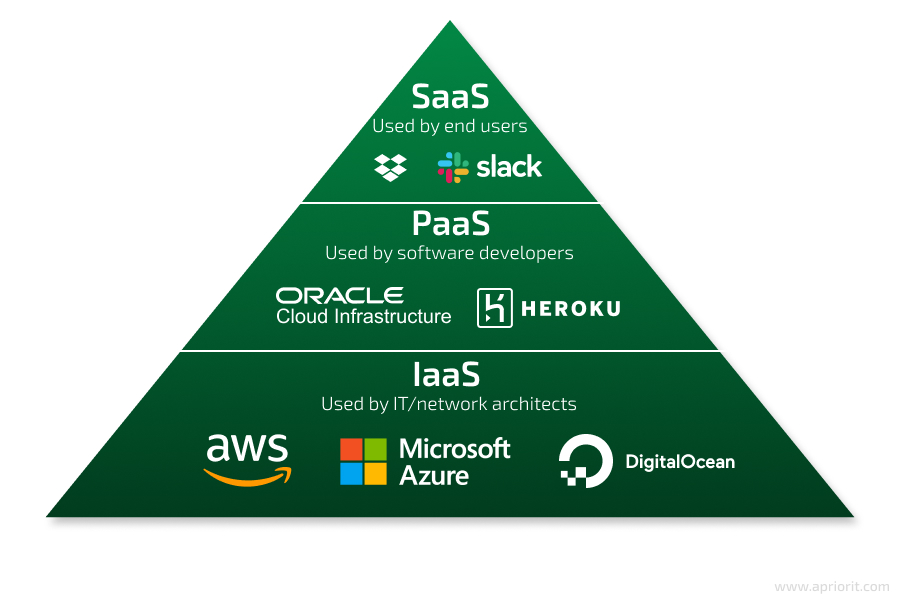
1. Software as a Service (SaaS). The SaaS model allows customers to use your application from any device and anywhere in the world without installing and configuring it. Examples of popular SaaS solutions are office software like Google Workspace, messengers like Slack, and storage services like Dropbox.
2. Platform as a Service (PaaS). PaaS solutions offer everything necessary for application development. In this model, a cloud service provider offers development tools, infrastructure, and operating systems that simplify app creation. Well-known examples of PaaS solutions are Oracle Cloud Platform, Heroku Platform, and Red Hat OpenShift.
3. Infrastructure as a Service (IaaS). With an IaaS solution, a service provider manages your business’s infrastructure — servers, network, and storage — through a public or private cloud. Your team can access IaaS infrastructure with an API or admin panel to manage operating systems and applications. Famous IaaS vendors are Amazon Web Services (AWS), Microsoft Azure, and DigitalOcean.
To get in-depth information about SaaS, PaaS, and IaaS as well as a detailed comparison of their characteristics and their pros and cons for your product, check out our article about cloud computing models.
Ready to deliver competitive software?
Bring your application to the cloud for improved accessibility and user engagement with the help of Apriorit specialists.
Why invest in delivering a cloud-based application
Cloud computing technologies help you enhance your IT project with access to robust computing resources, storage, and on-demand availability. When developing a cloud-based application, your team can leverage various development strategies and tools to make sure the final product brings efficiency, flexibility, scalability, and cost-effectiveness for end users.
Thanks to support for a wide range of devices, your app can target a wide audience, whether they prefer smartphones, tablets, or laptops. Also, your customers will value the ability to use offline mode and have their data easily and quickly synchronized once an internet connection is restored.
Benefits of developing cloud-based solutions
Powering your application with cloud computing technology can help you improve both the user experience and your app’s competitiveness thanks to the following business benefits:
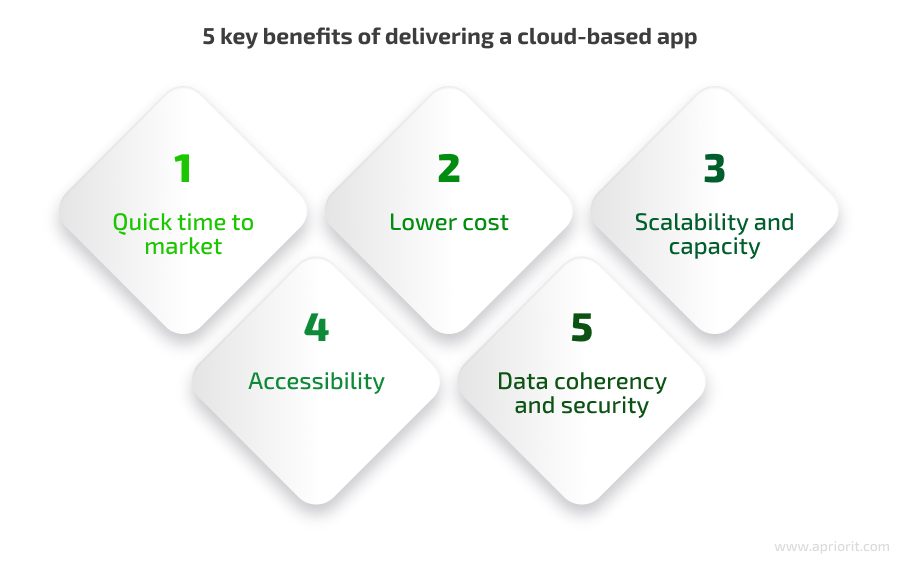
1. Quick time to market
When working on cloud apps, your team will need less time for configuring infrastructure and hardware compared to developing non-cloud apps, meaning you can enter the market relatively quickly. The cloud-native model also allows for fast deployment of new features.
Moreover, large cloud providers offer templates for common infrastructure and resource settings to help your team speed up the development process. Such advantages help your company reduce the product’s time to market and be more flexible to meet users’ requests for new functionality.
2. Lower cost
With cloud computing, you don’t need to invest in your own data centers. Also, your DevOps specialists and system administrators will save time on infrastructure configurations, allowing them to focus on other important project tasks.
As a cloud-based app owner, you only need to pay a fee to a cloud provider, who will handle all hardware, its maintenance, and support.
3. Scalability and capacity
To scale a cloud-based application, you don’t need to buy more physical servers and permanently expand your infrastructure. All you need to do is pay your cloud provider for more storage space and computing capacity. However, your team should build your app in a way that supports your chosen type of scaling and should accurately plan and control scaling-related expenses.
You can decrease or increase your storage at any time depending on what your business requires, without worrying about how to get a new server or get rid of an old one. Another great thing about cloud computing is that there’s really no limit to how much data you can store and how many computing resources you can request.
4. Application accessibility
Cloud computing allows both your team and your customers to manage data from any device and from any location as long as they have an internet connection. The data can be accessed, updated, retrieved, and deleted from anywhere.
5. Data coherency and security
With cloud computing, you’ll always have the same data on your server and on all clients, meaning that data is synced across all parts of your infrastructure. It will also be easy to recover data even if your local storage is damaged.
Cloud computing providers offer many services and features like granular permissions and access management to help your team prevent data loss and improve storage protection. However, responsibility for data security is shared, so your team must be careful when configuring security settings and should research and implement additional data protection measures.
The shift toward cloud-based solutions is not merely a trend but a strategic move that lots of companies choose. Let’s briefly explore the cloud app market to see how it’s growing.
Related project
Cross-Platform Data Backup Solution Development: Windows, Android, macOS, iOS
Find out how we helped our client attract more end users by building a secure cross-platform version of an existing Windows solution. Read the details of building an application that ensures data security and accessibility across platforms.
Cloud app market overview
The market for cloud-based applications is continuously growing. According to Statista, in 2020, this market was worth $133.6 billion. Maximize Market Research claims that the global cloud applications market was valued at $389 billion in 2022.
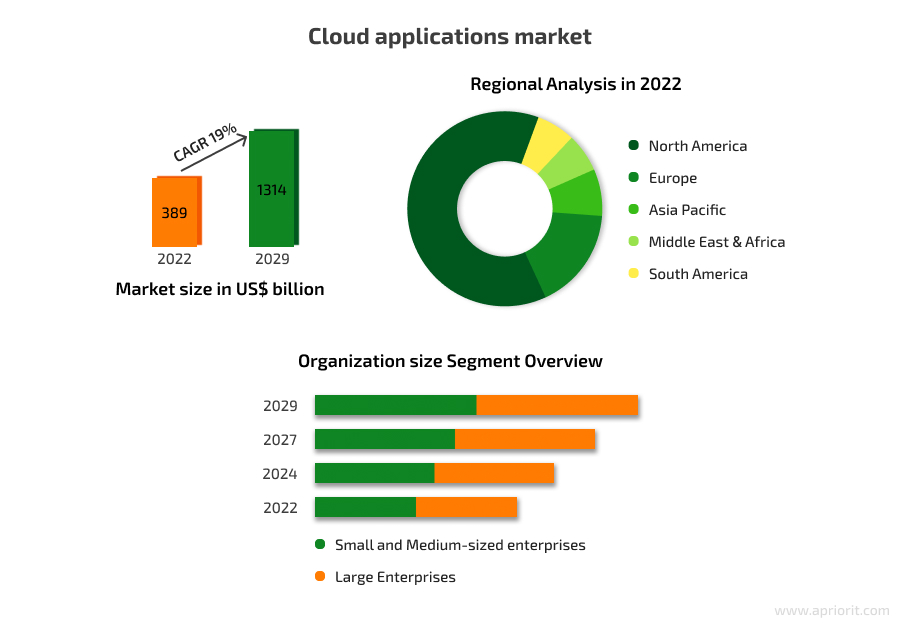
The main drivers of this market growth are the increased demand for mobility in data usage and management, demand for cost-efficient IT infrastructure, and the need to access data from multiple devices and from any location. Cloud-based apps offer mobility, accessibility, scalability, and reduced costs, so they’re an obvious choice for many businesses.
Previously, large enterprises were the main drivers of the cloud-based app industry, but now the market is growing mainly due to small and midsize enterprises that are interested in shifting to cloud app development.
Cloud-based apps are currently the most popular in the following industries:
- Education
- FinTech and banking
- Insurance
- Telecommunications and IT
- Government
- Healthcare and life sciences
- Media and entertainment
- Oil and gas
Healthcare is expected to be one of the largest consumers of cloud-based technology because of the growing requirements for data safety and transparency in this sector. Telecommunications is another industry that can benefit from cloud computing, as it requires sharing data with a large number of people.
What to know before starting a cloud app development project
Cloud app development hides many nuances and challenges, which vary depending on the project’s type, size, and other specifics. However, there are several key aspects to pay attention to when planning any cloud product:
- Technical expertise. Creating cloud applications requires close interaction between programmers, data architects, designers, and quality assurance (QA) managers. Your team needs to be familiar with various cloud platforms such as AWS, Microsoft Azure, Salesforce, and CloudStack. In addition, your team should choose the right approach for connecting with application programming interfaces (APIs) and content delivery networks (CDNs). A team with relevant technical expertise and rich experience in cloud development will help you choose the most suitable tools for your project.
- Scalability. One important reason why companies choose to deploy their solutions in the cloud is that cloud storage and computing power can be expanded easily and quickly. To ensure convenient scalability of your final solution, your development team must think about it during the early development stages. By analyzing estimated loads, you’ll be able to choose suitable service providers and architectural designs.
- Hosting costs. The potential size of cloud applications is virtually unlimited, but cloud hosting isn’t free. Concentrating user requests and optimizing data size should be top development priorities. Also, your DevOps specialists should be ready to carefully manage cloud hosting to prevent unnecessary costs.
- Data security. Protecting data isn’t always easy, since you’re dealing with cloud technologies that don’t have a single data access point. To win your target audience’s trust, make sure to securely store data by carefully planning data protection measures.
How much does it cost to build a cloud-based app?
The cost of developing a cloud-based application depends on many factors, including:
- Product features
- Product design
- Hourly rate of the development team
- Number of team members on the project
- Project size and complexity
- Technology stack
- Time frame
The biggest factor that influences a project’s cost is the hourly rate of developers, and that often depends on their location. For example, an application built in Ukraine can cost around 30% less than the same app developed by engineers in the US. And you’ll still receive expert development services and get an efficient product.
Building your cloud application with a company based in Eastern Europe is cost-effective and gives you access to top talent. For example, at Apriorit, we have skilled engineers and QA specialists with expertise in different areas, from mobile applications and low-level development to artificial intelligence solutions and reverse engineering.
Read also
IT Outsourcing to Eastern Europe in 2024: A Guide for Businesses
Achieve the perfect balance between cost and quality when hiring a software development team. Discover tips and tricks of outsourcing to Eastern Europe for your next successful project.

How to develop a cloud-based application: step-by-step instructions
The best approach to developing a particular cloud application will depend on its type, cloud computing model, infrastructure configuration, target industry, feature set, and so on. However, there are common steps in building any cloud-based software.
Let’s explore a typical eight-step workflow for building a cloud-based app:
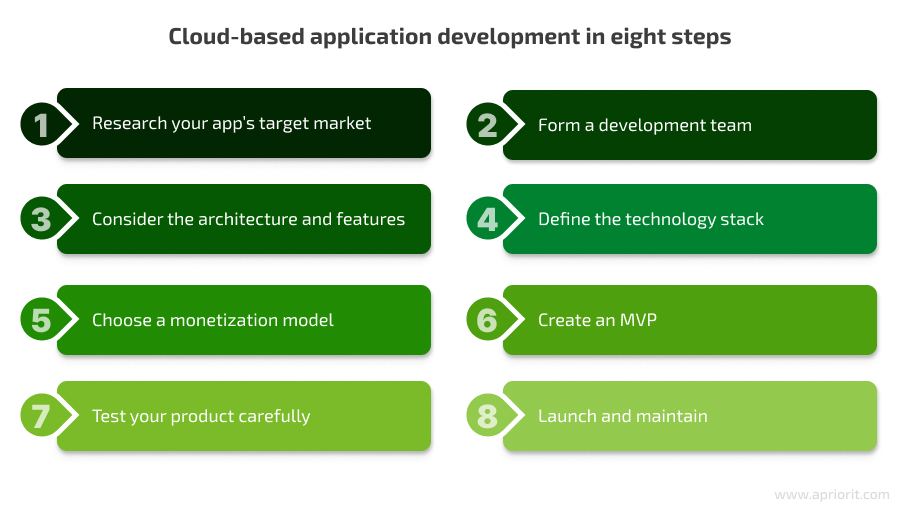
Step #1. Research your app’s target market
When developing any cloud-based app, for example, a mobile banking app, the first thing you need to consider is the target audience. Understanding your users’ needs makes development easier and leads to a successful final product. Make sure to involve professional business analysts who will help you find out as much as possible about your potential users.
Your team can start by researching the target audience’s demographics to discover the average age of your users, where they live, what devices they use, etc. Also, analyze behavioral trends to see what prevents users from downloading your app, how they expect you to secure their data, and so on.
To develop an engaging cloud application that attracts customers, we suggest:
- Creating a user persona
- Conducting competitor analysis
- Defining clear acceptance criteria
Step #2. Form a development team
The second step is to assemble a development team with relevant skills, expertise, and experience. Depending on where your company stands on software engineers, you can work with an in-house team, fully outsource development to a third-party vendor, or use a hybrid approach.
When outsourcing the entire software development project or only particular tasks to contractors, pay attention to businesses that offer different pricing models so you can choose a model that’s suited to your particular project. This way, you can minimize the risk of unexpected expenses and choose a convenient model of engagement.
Note that before starting cloud application development, you should carry out a discovery phase, during which your team will:
- Perform a professional business analysis
- Create a clear and accurate software requirements specification
- Plan project processes, including development, testing, delivery, and maintenance
- Estimate the development cost
Before diving into actual software development, your team should create an app development workflow, choose the main features for the app, and design the app’s concept. After that, you can proceed to creating project milestones and working on the minimum viable product (MVP).
Step #3. Consider the architecture and features
Developing cloud apps is different from developing on-premises applications. Cloud development starts with choosing a service provider. AWS and Microsoft Azure are probably the most reliable providers on the market, as their platforms offer a number of great tools and features for developing cloud applications. However, the final choice will depend on your product’s specifics, business goals, and requirements.
For your application to be successful, you need to carefully consider the architecture and service model. These decisions affect your application’s performance, so it’s best to consult with specialists.
- Architecture. Though classic monolithic solutions are always reliable, for cloud applications, it’s more common to use microservices. This architectural approach allows for quickly adding new features and easily scaling each service.
- Service model. The service model you select — SaaS, PaaS, IaaS — must match the type of cloud solution you’re developing. For example, when developing an application like Slack, you should take a SaaS approach to make sure customers can quickly start using your app without worrying about their configuration and maintenance.
Step #4. Define the tech stack
When choosing tools for developing cloud applications, consult experts. This way, you can avoid pitfalls like choosing incompatible tools or missing more affordable alternatives. At Apriorit, we analyze clients’ requirements, features, and designs to help them select the right set of technologies for their products.
The choice of cloud application development solutions and services always depends on the project specifics. Here’s an example of what a technology stack for a cloud-based application can look like:
| Utilities | DevOps | Business tools | Application and data |
|---|---|---|---|
| Google Analytics | Jenkins | Jira | Akamai |
| Twilio | Bitbucket | Google Workspace | Cloudant |
| Optimizely | New Relic | InVision | ClearDB |
| Heap | Datadog | Salesforce Sales Cloud | |
| Recurly | Puppet Labs | Balsamiq | |
| Zuora | Cloud9 IDE | DocuSign | |
| Cyfe | Sauce Labs | UXPin | |
| TransmogrifAI |
Step #5. Choose a monetization model
The next step is to choose the right monetization model for your application. Now that you know your users’ needs, you can predict what your users will pay for. Here are four monetization models to choose from:
- Paid: users pay once to access your app
- Freemium: users can download your app for free, with the ability to upgrade to use premium features
- In-app purchases: users can pay for different items, features, or content inside the app
- Advertising: models vary depending on the chosen ad options
- Cost per click: advertisers are charged every time a user interacts with their ads
- Cost per mille: advertisers pay for every 1,000 ad impressions
- Cost per action: advertisers pay only when users complete a target action, such as installing an app or signing up for a newsletter
Related project
Building a Microservices SaaS Solution for Property Management
Find out how to drastically improve your product by increasing the flexibility of its architecture and simplifying the process of adding new features. Explore the success story of an Apriroit client who hired us to update their SaaS solution’s design and replace the current monolithic platform with microservices.
Step #6. Create an MVP
Creating a cloud-based app is a big and complex project. We recommend launching an MVP first and testing its technical and business performance. Using this approach, you’ll be able to find out what users like and don’t like in your app. Then you’ll be able to consider their feedback and improve your app.
Step #7. Test your product carefully
As with any software, cloud-based app development should include thorough testing activities to ensure the product’s quality. Before launching your product, your team must test it to find and fix bugs.
At this point, you’ll verify that your application works correctly and provides a satisfying user experience. To do this, it’s best to cooperate with a full-cycle development company. Full-cycle development companies offer development, design, testing, and management services. With one team working on your project from start to finish, communication is vastly simplified. This results in higher product quality.
Step #8. Launch and maintain
Once your software is ready, deploy it to the chosen cloud platform. During this stage, your team usually has to:
- Configure the infrastructure: load balancers, databases, networking components, etc.
- Automate deployment using tools like AWS Elastic Beanstalk or Kubernetes.
- Implement auto scaling to ensure performance during peak loads.
- Set up monitoring to track the app’s performance and detect issues.
If your project includes cloud-based mobile apps, you can release them on the App Store (iOS) and Google Play (Android). When doing this, there are a few things to keep in mind:
- Before your app is published on either app store, it must go through an approval process. This procedure can take some time and may require additional development costs.
- Google Play uses automated testing to speed up the app store approval process. However, if your application is rejected by Google, it can be difficult to find out why.
- The App Store delegates app validation to real people. If validators don’t approve your app, they’ll ask you to make specific changes.
- If your app isn’t accepted, your team can make changes and try again. However, keep in mind that the number of attempts might be limited. For example, Google Play can terminate developer accounts in case of repeated or serious policy violations.
Pro tip: When interviewing software development companies, make sure to ask whether they provide their services until your app gets approved and how they charge for this project phase. This will help you better plan your expenses and set clear project expectations with contractors.
After the launch, your team should keep an eye on how your software performs and fix any issues that may arise. Further app maintenance usually includes the following activities:
- Updating security measures and adding patches to protect user data
- Optimizing the app’s performance to ensure responsiveness to evolving user demands
- Adjusting scalability as traffic changes
- Introducing smooth updates when frameworks and libraries used in the app are updated
Read also
Multi-Cloud Computing: Use Cases, Pros, and Cons for Enterprises
Choose the most suitable cloud computing approach for your project. Discover valuable insights about multi-cloud computing along with Apriorit’s recommendations on which type of cloud computing to choose.

How Apriorit can help you
With 20+ years of experience in the software development market, Apriorit has gained all the necessary knowledge and insights to help you deliver an app that meets your business needs and engages your users.
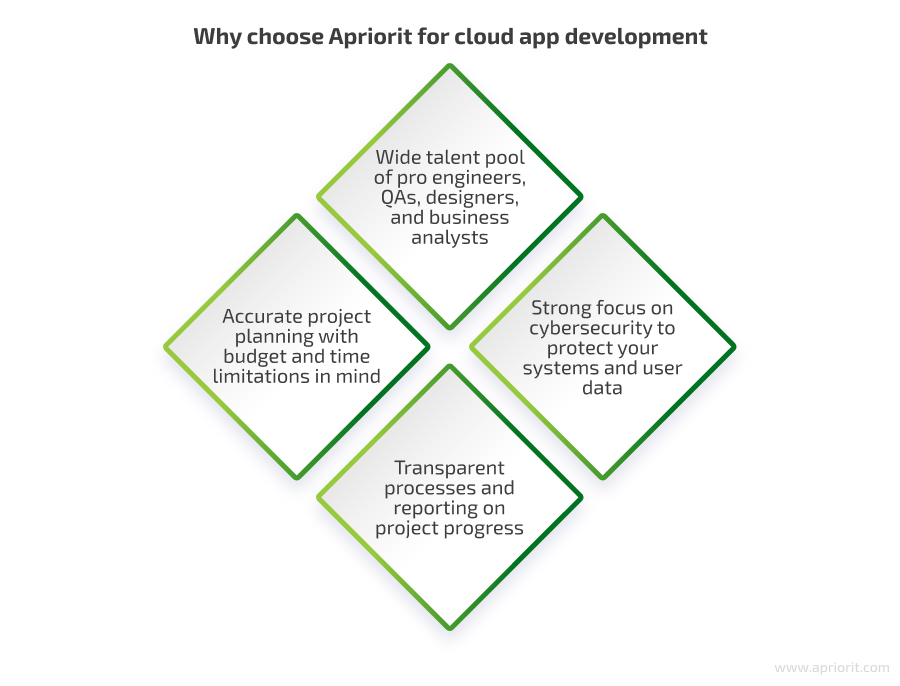
By delegating cloud-based app development to us, you’ll receive:
- A thoughtfully and beautifully designed software application deployed in a reliable cloud environment
- Solid scalability opportunities to keep your app working even during unexpected traffic spikes
- High efficiency and flawless performance thanks to a wisely chosen toolset and adherence to software development and testing best practices
- A rich set of features that meet the target audience’s needs, providing a top-notch user experience
- Secure and convenient data storage to help your product handle as much data as your business needs without worrying about leaks and breaches
Conclusion
Choosing cloud computing technology as the backbone of your mobile or web application will help your team optimize development processes, meanwhile providing users with accessibility and ease of use.
However, to deliver a solution that truly stands out, you need skilled developers and QA specialists with relevant experience. It’s essential to gather an expert team that knows how to develop a cloud-based application that meets business needs. Cloud app development hides numerous nuances related to choosing the right service provider, setting up the environment, picking the technology stack, etc.
Qualified Apriorit engineers are ready to help you build a reliable SaaS solution and configure solid cloud infrastructure. With experience delivering cloud apps for various industries, we know what challenges to expect and how to efficiently handle them.
Planning to expand your business online?
Develop a competitive cloud application with Apriorit. We’ll turn your ideas and vision into powerful and secure solutions.




